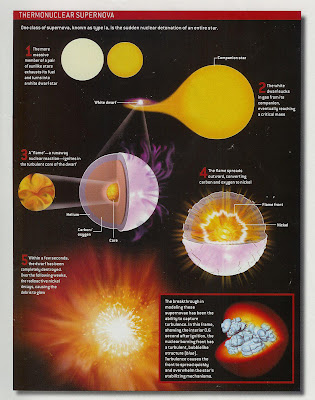43. SUPERRNOVA TYPES
A supernova is a stellar explosion which produces an extremely bright object that fades to invisibility over weeks or months. A supernova may briefly overshine its entire galaxy, It would take bilions of years for the sun to produce the energy output of an ordinary Type II supernova. There are at least two possible routes to their formation. A massive star may cease to generate "fusion energy" from fusing the nuclei of atoms in its core and collapse under the force of its own gravity to form a neutron star or black hole. It is the Type II supernova.
Alternatively a white dwarf star may accumulate material from a companion star until it nears its "Chandrasekhar limit" ( 1.2 - 1.4 sunmasses), then it undergoes runaway nuclear fusion in its interior, completely disrupting it. This the Type I supernova.

TYPE I Supernova:
This type is the brightest kind of supernovae. The companion star is often a red giant. The process is sometimes called: "stellar cannibalism": the white dwarf soak up the outer layers of the red giant, increasing its mass, raising the temperature near the center. At some point carbon fusion is born causing within a period of only a few seconds the integral temperature to raise to billions of degrees. Then the star explodes violently, releasing a shockwave while matter is ejected at speeds of 5 - 20.000 km/sec (3 % of the light speed). The energy released in the explosion increases the luminosity up to
~ 5 x 10^9 times brighter than the sun, that's what we observe then.

TYPE II sueprnova:
Stars much more massive, typically more then eight solar masses, evolve in more complex fashions. First hydrogen is fused into helium, releasing energy which heats the core providing pressure against gravitation forces. The very high core mass stimulates further contraction as hydrogen is exhausted, inducing helium fusion, carbon fusion and fusing to progessively heavier elements. In between the core collapses further until iron is produced, the most stable atoms in nature, resulting in no more temperature raising, no more counterpressure and a density in the core of more than one million kg per cm3! This happens within seconds. Because of the enormous mass the star core collapses by gravitation, an unstoppable implosion, and a neutron star remains. Once the collapse stops, the infalling matter from the surrounding layers rebounds, producing a shockwave that propagates outwards causing the outer layers to explode.
Labels: expansion

0 Comments:
Post a Comment
Subscribe to Post Comments [Atom]
<< Home